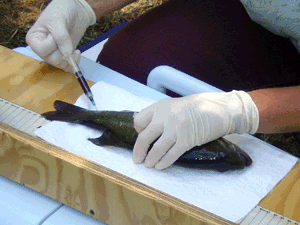Eighty five percent of male smallmouth bass and 27 percent of male largemouth bass tested in waters in or near 19 National Wildlife Refuges in the Northeast U.S. were intersex, according to a new study by U.S. Geological Survey and U.S. Fish and Wildlife Service researchers published in Ecotoxicology and Environmental Safety. The authors said the report would “provide a necessary benchmark for future monitoring.” They collected smallmouth and largemouth bass from in or near 19 refuges located between Ohio, Virginia, and Maine. The Missisquoi National Wildlife Refuge on Lake Champlain was included in the study.
Intersex is when one sex develops characteristics of the opposite sex. It is tied to the exposure of fish to endocrine-disrupting chemicals that can affect the reproductive system and cause the development of characteristics of the opposite sex, such as immature eggs in the testes of male fish. Intersex is a global issue, as wild-caught fish affected by endocrine-disrupting chemicals have been found in locations across the world. Endocrine-disrupting chemicals are derived from a variety of sources, from natural estrogens to synthetic pharmaceuticals and agrochemicals that enter the waterways. Examples include some types of birth control pills, natural sex hormones in livestock manures, herbicides and pesticides. They may get into water from agricultural production, both animal feeding areas and pesticides and manure applied to crop lands, or through wastewater treatment effluent.
"The results of this new study show the extent of endocrine disrupting chemicals on refuge lands using bass as an indicator for exposures that may affect fish and other aquatic species," said Fred Pinkney, a USFWS contaminants biologist and study coauthor. The authors recommend management actions that reduce runoff into streams, ponds and lakes. The study further reinforces the need to change land use practices to better protect water quality.
Intersex issues were less common near the Missisquoi Bay Refuge compared to other sites, though still very high for smallmouth bass. For individual sites, the study found ratesof 60 to 100% intersex in smallmouth bass and 0 to 100% in largemouth. In the Missisquoi River 60-70% of smallmouth showed intersex features. No largemouth collected in Missisquoi Bay had intersex features.
Smallmouth bass are more likely to exhibit intersex features than largemouth. A previous study published in 2009 reported rates of intersex of 33% and 18% respectively, but that work did not include northeastern states. Other studies from the northeast have shown even higher rates of intersex in largemouth bass. Smallmouth may live in waters more likely to be contaminated with endocrine disruptors, or they may be more sensitive to the disruptors. It is not clear how often intersex occurs in bass naturally, but there are reports in the 0% to 15% range, and there appears to be a correlation between increased prevalence of intersex fish and increasing human impacts on the landscape. We need a better understanding of how intersex conditions occur to protect fish populations.
